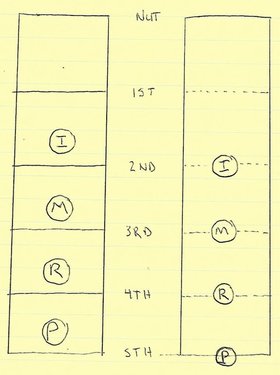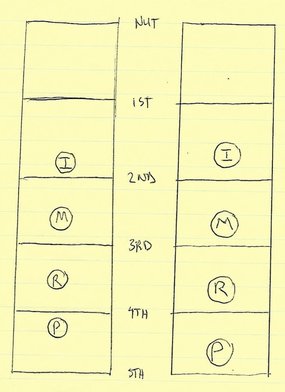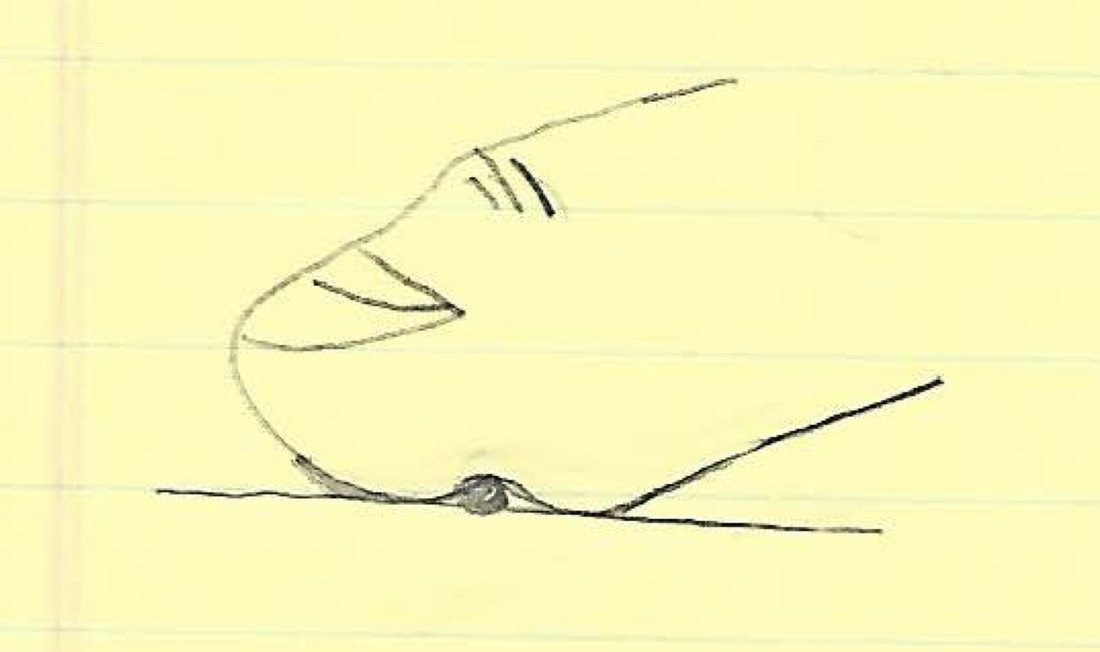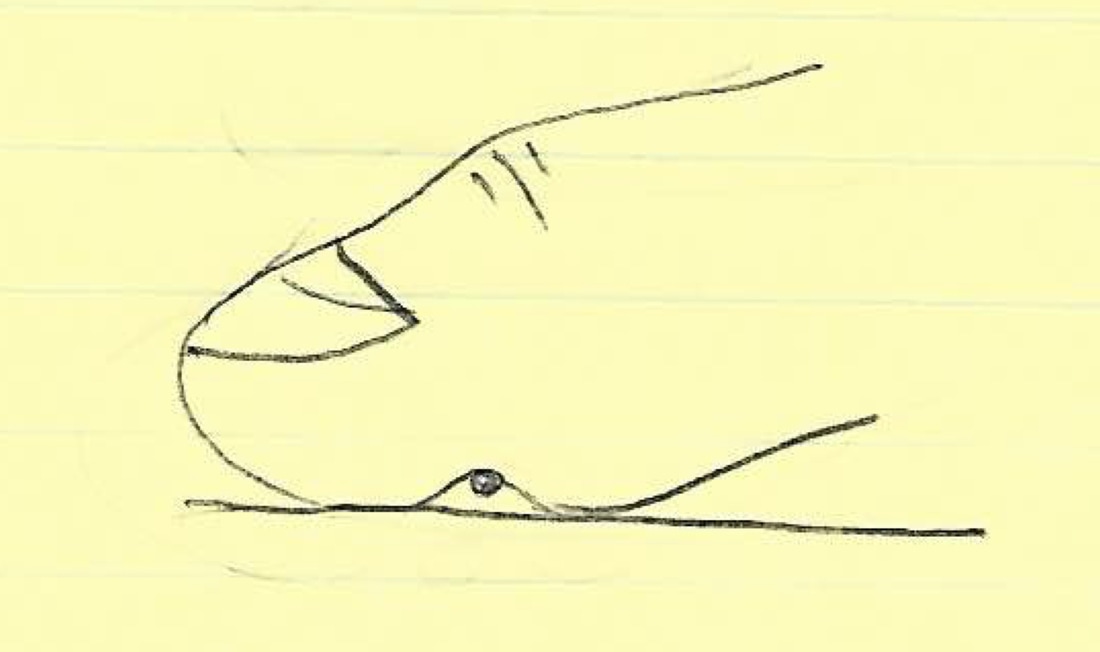|
In this week's post I thought I'd give a few thoughts on fretless playing. It should be noted up front that while I love listening to fretless banjos, especially those of the deeply-plunky variety (e.g. Light and Hitch & the Flat Iron Stringband....), I consider myself merely a fretless hobbiest, and would likely never be comfortable going to a festival with only a fretless in tow. However, everyone's got room for more than one banjo in their world and I do have a couch-plunking fretless that I spend a lot of time with. Still, what follows is best characterized as an outsider's perspective on a couple of considerations about fretless playing:
1) Where do your fingers go? Yes, I specifically mean the fingers of your left hand. The best way to figure this i out is by trial and error - therefore I wouldn't grab a fretless until you've sharpened your ear with frets for a few years; if your banjo rarely sounds out of tune and you rarely have to tweak the tuning between songs.....well, you've either got a magic banjo the likes of which I've never seen, or (more likely) your ear may not be quite "there" yet. However, if you consider yourself a tuning-tweaking fanatic, you're ready to dig the notes out of the void that is a de-fretted fingerboard. Option two is to "fake it till you make it" by getting a flush-fret banjo (one that has faux fret marks for guidance); absolutely no shame in this approach. What I really wanted to point out here is the following, however: finger placement on a fretless necessarily differs from finger placement on a fretted banjo. This is for a very simple reason: on a fretted banjo, you place your fingers behind the frets (i.e. toward the headstock), while on a fretless banjo, you place your fingers where the frets would be; therefore you end up playing just a bit up the neck from where you would play. This is illustrated in Figure 1:
Figure 1 - Left hand finger positioning on a fretted (left) and fretless (right) banjo fingerboard on banjos with the same scale length.
I = index finger; M = middle finger; R = ring finger; P = pinky finger.
To me, the new role of "being" the frets, can affect scale-length considerations when buying a fretless, especially if you dutifully adhere to hand positions as I do (here). If you look at Figure 1, you'll notice that I've placed "fingers" right behind frets on the fretted neck. While this is the ideal position for buzz-free playing (as long as you don't push down too hard, which can make your notes go a bit sharp) you do have a bit of leeway here. For instance, using the same hand position, you could place your index finger right behind the 2nd fret, and your pinky finger right in front of the 4th fret as follows:
Figure 2 - How frets allow you to "shorten your reach." Using the finger positions on the left (with your index finger just behind the 2nd fret and your pinky just in front of the 4th fret), you can reach frets 2-5 with a shorter distance between each finger than normally necessary (optimal finger position is shown on the right).
While the fingering shown in Figure 2 may be a bit sloppy, that probably wouldn't matter in faster playing, and you've effectively shortened the reach your left hand has to cover between the 2nd and 5th frets. As you can imagine, this approach is not applicable on a fretless if you're interested in playing in tune; you always have to stretch that pinky out to get the right notes. Tiny changes in scale length can therefore make a huge difference in just how much stretching you have to do in fretless playing; I prefer slightly shorter scale lengths in a fretless banjo (24-25") than I do for a a fretted banjo. If you'd like to guess a scale length for a fretless, you can try playing by placing your fingers on top of the frets of your fretted banjo; you may find that your current scale length feels like a bit of a stretch. If so, try capo-ing until its comfortable; whatever scale length you end up feeling comfortable with is close to optimal for your hands in fretless playing.
2) Nylon/nylgut or steel strings? You may have noticed that many people, even those who play steel strings on fretted banjo, prefer nylon/nylgut strings for fretless playing. There are a couple stated reasons for this. First off, some will point out that steel strings damage a wooden fingerboard over time, which may be true. This may explain some of the reasoning behind brass fingerboard overlays on fretless banjos (though they're also fun for sliding around the fingerboard). However, the biggest reason for my nylon/nlygut string preference on fretless is this: its just really hard to push plain steel strings down hard enough to make good contact with the fingerboard. More on this below: When you're pressing down strings on a fretted banjo, you only have to press hard enough to get the string to touch the fret; for the most part, this isn't a big deal (in fact banjo players typically have a lot easier time of this than guitarists or mandolin players). The solid contact between the string and the fret provides a solid node to create the standing wave of string vibration (Physics!!) that is necessary for a crisp note (i.e. a non-warbly, non-muted note like one created on a fretted banjo). On a fretless banjo, a crisp note can only be created by pressing the strings all the way to the fingerboard, providing a hard surface against which to make a node in the absence of frets. This is typically not an issue for wound steel strings, which are nice and fat, making them pretty easy to press against the fingerboard. Thinner, unwound strings (particularly the 1st and 2nd strings) tend to get lost in the pad of my finger rather than laying flush against the fingerboard. Here's a bit of an illustration:
Figure 3 - Pressing strings to the fingerboard on a fretless banjo. Left - illustration showing a finger pressing a thick (either wound-steel or nylon/nylgut) all the way to the fretboard; though the string digs into the pad of the finger a bit, it still makes contact with the fingerboard. Right - similar illustration with a thinner string; notice that the string is not quite making contact with the fingerboard though the pad of the finger is touching the fingerboard.
Due to the mechanisms cartoonishly outlined above, I really can't get crisp notes out of 1st or 2nd steel strings of a fretless banjo without applying crazy amounts of pressure. My "fretted" notes on these strings therefore end up sounding muted in comparison to open strings or notes on the wound strings. In my experience, brass fingerboard overlays do not solve this problem. Lowering the nut (and therefore string action near the nut) can help a bit, but this solution ends up feeling a bit strange to me and I still have to apply more-than-normal pressure to get crisp notes (basically, the extra effort is to get the string out of my finger pad). Some people manage to play steel strung fretless without issue. Presumably they either: 1) don't mind the muted notes, 2) push really really hard with their left hand, 3) have bonier fingers than I do, 4) press with the fingertips rather than pads, or 5) grow out the nails on their left hand to provide a hard surface for the strings to push against. I've read about option #5 on banjo hangout; with all the fussing I do about my single right hand banjo nail, I find this last solution especially unappealing....
As hinted at above, I solve my muted note problem by using nylon/nylgut strings on fretless banjos. Since the strings are both fatter and stretchier than plain steel strings they don't get lost in the pad of my finger like steel strings do. I've noticed that many other people employ this option as well, and many of the fretless banjos that show up at Elderly arrive with nylon/nylgut strings in place. Out of the two options (nylon or nylgut), I guess I prefer the latter, though I haven't experimented that much to be honest; as an aside I've never tried real gut strings though I'm sure that there are some purists out there who swear by them. I do like that many nylgut sets come with unwound 4th strings - theres just something kind of fun about sliding around on a big fat string and its nice to have a 4th string that isn't tonally distinct from the rest of the set. My only caution (especially if you try out the "red" nylguts) is to bring strings up to tension very slowly (like over a matter of days); stretching them too quickly inevitably results in breakage. 3) When/how to slide? Slides are what make playing fretless fun! So, when/how do you do them? Well, I've instinctually fallen into the following pattern: I only into quarter notes, and I pretty much always start my slides from a 1/2 step below the note. The slide effectively turns the quarter note into two 8th notes, the first of which is occupied by the slide. To demonstrate what I'm talking about, lets take the opening phrase of Spotted pony, which I've previously dissected ad nauseam (here).
Figure 4 - The A part Walkup to "Spotted Pony" with ghost notes as filler. Tab is meant to be played in double D tuning (aDADE).
Note that the hand position for the above tab is that shown in Figures 1 and 2. On a fretless banjo, we can spice up the A part walkup to "Spotted Pony" shown in Figure 4 by "sliding in" to the 2nd note of the phrase like this:
Figure 5 - The A part Walkup to "Spotted Pony" with an added slide.
When playing this phrase, reach back with your index to get the note on the 1st fret, then slide up to the second fret; no need to rush...it should take approximately 1/2 a beat to slide up to the 2nd fret. By playing this way, you end up "sliding in" to the correct hand position, which is handy : ) By sticking in 1/2 step slides, you also often end up hitting notes outside of the key a tune is in (like the D# in Figure 5). This definitely adds some flavor to a tune. While Figure 5 shows the addition of a flattened 2nd, its really fun to add flattened 3rds and 7ths in to a standard major/ionian tune for a bluesy feel (click here for my post on modes if you don't know what I'm talking about...).
In my opinion, this is a tasteful way to put slides into tunes without too much effort. However, this is obviously not the only way to slide around on a fretless - for example: you could slide down into notes; furthermore, slides could span a whole step or more, and last for a full beat or longer. Once you've started sliding around on a fretless, you may even be tempted to slide about on your fretted banjo as well : ) ------------- Hope that was interesting to someone other than myself : ) If you don't already have a fretless, you may consider adding one to your arsenal! I thought I'd end this post with a tune; here's me playing the 3 part G tune "Josio" on my nylgut strung fretless:
"Josio" played on a fretless banjo tuned in gDGDE (or maybe a relative tuning a few steps down).
Thanks for reading - see you next week!
2 Comments
Stew
3/27/2017 10:42:37 am
Several things:
Reply
Jeff N
3/29/2017 10:33:31 am
Hey Stew - good to hear from you!
Reply
Leave a Reply. |
-----
|






 RSS Feed
RSS Feed